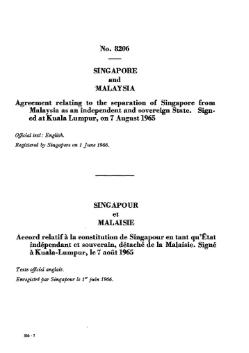Top Qs
Timeline
Chat
Perspective
Independence of Singapore Agreement 1965
Treaty between Malaysia and Singapore From Wikipedia, the free encyclopedia
Remove ads
The Independence of Singapore Agreement 1965 was a pivotal agreement concluded between the governments of Malaysia and Singapore on 7 August 1965. It provided the legal and constitutional framework for Singapore's formal secession from Malaysia, wherein it ceased to be a constituent state and assumed the status of an independent and sovereign nation. The terms of the agreement encompassed a Proclamation to be issued by Malaysian Prime Minister Tunku Abdul Rahman, while a separate Proclamation of Singapore was delivered by Singaporean Prime Minister Lee Kuan Yew.

Pursuant to this accord, Singapore was irrevocably and unambiguously separated from Malaysia with effect from 9 August 1965, thereby rendering the Malaysia Agreement inapplicable in so far as it pertained to Singapore. Subsequently, Singapore acceded to membership in the United Nations on 20 September 1965, following a unanimous resolution of the General Assembly.[2] The Singapore Act 1966, enacted by the Parliament of the United Kingdom a year later, gave statutory recognition to the agreement and admitted Singapore into the Commonwealth of Nations with retrospective effect from the date of independence.[3]
Remove ads
Background
Summarize
Perspective
Singapore attained sovereignty on 3 June 1959 from the United Kingdom, becoming a self-governing polity with full internal autonomy. Nonetheless, control over its external affairs remained vested in the British colonial administration, reflecting a constitutional arrangement akin to that of the Irish Free State. Between 1959 and 1963, Singapore operated as a de facto state in all domestic matters. On 16 September 1963, the Proclamation of Malaysia was promulgated, signifying the formation of a new federation encompassing four constituent territories: the Federation of Malaya, North Borneo (now Sabah), Sarawak and Singapore. By this juncture, Sarawak, Sabah and Singapore were all self-governing colonies, and upon accession to the federation, Singapore assumed the status of an autonomous state, parallel to that of the other two Bornean entities.
Prior to the final agreement, an alternative constitutional model in the form of a looser confederation had been proposed. Under this scheme, Singapore would revert to the self-governing status it had enjoyed between 1959 and 1963, but within a broader Malaysian framework wherein Kuala Lumpur would assume responsibility for defence and foreign affairs, mirroring previous British oversight. Security matters would be managed jointly through an Internal Security Council. Crucially, Singapore's tax revenue would be remitted to the federal government, yet it would forfeit legislative representation in the Malaysian Parliament. This provoked significant opposition, most notably from Lee Kuan Yew, who argued to Tunku Abdul Rahman that "Singapore cannot become a colony in Malaysia", invoking the principle of no taxation without representation. British authorities also objected to the proposal, fearing that a diluted federal structure might engender instability at a time when regional tensions were high due to the Konfrontasi with Indonesia.[4]
Legacy
The brief union would ultimately prove precarious owing to a confluence of factors, most notably profound political and economic divergences. It endured for merely 1 year, 10 months and 24 days before the terms of the agreement came into force on 9 August 1965.[5] By contrast, Sarawak and Sabah have remained part of Malaysia.
Remove ads
See also
References
Wikiwand - on
Seamless Wikipedia browsing. On steroids.
Remove ads

